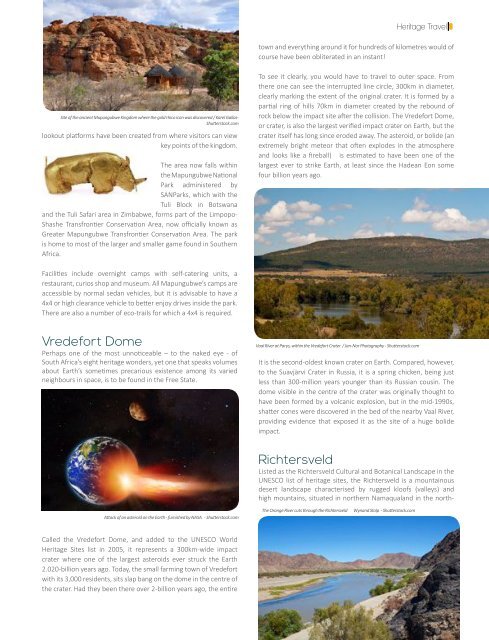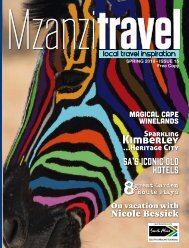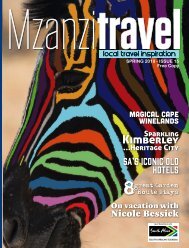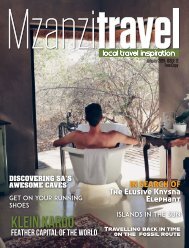You also want an ePaper? Increase the reach of your titles
YUMPU automatically turns print PDFs into web optimized ePapers that Google loves.
Heritage Travel<br />
town and everything around it for hundreds of kilometres would of<br />
course have been obliterated in an instant!<br />
Site of the ancient Mupungubwe Kingdom where the gold rhico icon was discovered / Karel Gallas-<br />
Shutterstock.com<br />
lookout platforms have been created from where visitors can view<br />
key points of the kingdom.<br />
The area now falls within<br />
the Mapungubwe National<br />
Park administered by<br />
SANParks, which with the<br />
Tuli Block in Botswana<br />
and the Tuli Safari area in Zimbabwe, forms part of the Limpopo-<br />
Shashe Transfrontier Conservation Area, now officially known as<br />
Greater Mapungubwe Transfrontier Conservation Area. The park<br />
is home to most of the larger and smaller game found in Southern<br />
Africa.<br />
To see it clearly, you would have to travel to outer space. From<br />
there one can see the interrupted line circle, 300km in diameter,<br />
clearly marking the extent of the original crater. It is formed by a<br />
partial ring of hills 70km in diameter created by the rebound of<br />
rock below the impact site after the collision. The Vredefort Dome,<br />
or crater, is also the largest verified impact crater on Earth, but the<br />
crater itself has long since eroded away. The asteroid, or bolide (an<br />
extremely bright meteor that often explodes in the atmosphere<br />
and looks like a fireball) is estimated to have been one of the<br />
largest ever to strike Earth, at least since the Hadean Eon some<br />
four billion years ago.<br />
Facilities include overnight camps with self-catering units, a<br />
restaurant, curios shop and museum. All Mapungubwe’s camps are<br />
accessible by normal sedan vehicles, but it is advisable to have a<br />
4x4 or high clearance vehicle to better enjoy drives inside the park.<br />
There are also a number of eco-trails for which a 4x4 is required.<br />
Vredefort Dome<br />
Perhaps one of the most unnoticeable – to the naked eye - of<br />
South Africa’s eight heritage wonders, yet one that speaks volumes<br />
about Earth’s sometimes precarious existence among its varied<br />
neighbours in space, is to be found in the Free State.<br />
Vaal River at Parys, within the Vredefort Crater / Jan-Nor Photography - Shutterstock.com<br />
It is the second-oldest known crater on Earth. Compared, however,<br />
to the Suavjärvi Crater in Russia, it is a spring chicken, being just<br />
less than 300-million years younger than its Russian cousin. The<br />
dome visible in the centre of the crater was originally thought to<br />
have been formed by a volcanic explosion, but in the mid-1990s,<br />
shatter cones were discovered in the bed of the nearby Vaal River,<br />
providing evidence that exposed it as the site of a huge bolide<br />
impact.<br />
Richtersveld<br />
Listed as the Richtersveld Cultural and Botanical Landscape in the<br />
UNESCO list of heritage sites, the Richtersveld is a mountainous<br />
desert landscape characterised by rugged kloofs (valleys) and<br />
high mountains, situated in northern Namaqualand in the north-<br />
Attack of an asteroid on the Earth - furnished by NASA - Shutterstock.com<br />
The Orange River cuts through the Richtersveld<br />
Wynand Stolp - Shutterstock.com<br />
Called the Vredefort Dome, and added to the UNESCO World<br />
Heritage Sites list in 2005, it represents a 300km-wide impact<br />
crater where one of the largest asteroids ever struck the Earth<br />
2.020-billion years ago. Today, the small farming town of Vredefort<br />
with its 3,000 residents, sits slap bang on the dome in the centre of<br />
the crater. Had they been there over 2-billion years ago, the entire

















